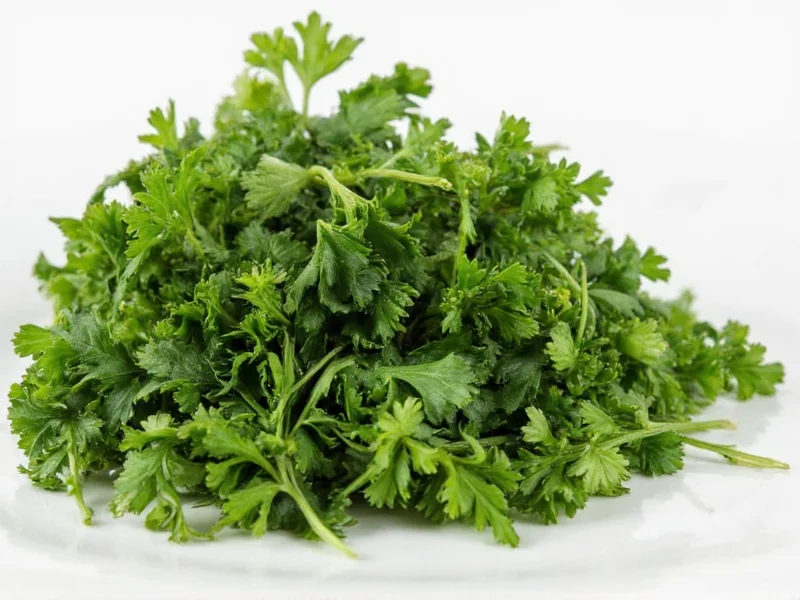Understanding Dried vs. Fresh Parsley Differences
When substituting dried parsley for fresh, understanding their fundamental differences is crucial for successful cooking. Fresh parsley offers a bright, grassy flavor with subtle peppery notes and a crisp texture. Dried parsley loses some volatile oils during dehydration, resulting in a more muted, earthy flavor profile with less complexity.
The drying process concentrates certain compounds while diminishing others. This explains why you need less dried parsley by volume—typically one-third the amount of fresh. The texture difference also matters: fresh parsley provides a pleasant bite in salads and as garnish, while dried parsley dissolves into sauces and stews.
Precise Conversion Guidelines for Cooking
Getting the dried parsley substitute for fresh measurement right prevents overpowering your dish. The standard conversion works because drying removes moisture, concentrating the herb's essential oils. Here's a detailed reference:
| Recipe Requires (Fresh) | Dried Parsley Substitute | Best For |
|---|---|---|
| 1 tablespoon | 1 teaspoon | Sauces, soups, stews |
| 1/4 cup | 1 tablespoon | Meatloaf, stuffing, casseroles |
| 1/2 cup | 1.5 tablespoons | Long-simmered dishes |
| 1 cup | 3 tablespoons | Large-batch cooking |
Always add dried herbs early in the cooking process to allow rehydration and flavor dispersion. For the best dried parsley substitute for fresh results, crush the dried herb between your fingers before adding to release more flavor compounds.
Alternative Substitutes When Dried Parsley Isn't Available
If you need a dried parsley substitute for fresh but don't have dried parsley either, consider these alternatives based on your recipe:
- Cilantro (use 3/4 amount): Works well in Mexican, Asian, and fresh salsas but has a distinctly different flavor profile
- Dried celery leaves (1:1 ratio): Offers similar earthiness, ideal for soups and stocks
- Dried chervil (1:1 ratio): More delicate flavor, excellent in French cuisine
- Italian seasoning blend (use half amount): Contains parsley plus complementary herbs
For the most accurate dried parsley substitute for fresh experience in cooked dishes, consider making your own dried parsley by air-drying fresh sprigs. This preserves more flavor compounds than commercially dried versions.
Practical Application Tips
Understanding when to use dried versus fresh parsley makes a significant difference in your cooking results. For the best dried parsley substitute for fresh adaptation:
- Add dried parsley during the last 20-30 minutes of cooking to preserve flavor
- Reconstitute dried parsley in warm water (1 tsp dried + 2 tsp water) for salad applications
- Store dried parsley in an airtight container away from light and heat
- Test dishes containing dried parsley substitute for fresh 5 minutes before serving and adjust seasoning
- Combine with a pinch of lemon zest to mimic fresh parsley's brightness
Remember that dried parsley substitute for fresh works best in cooked applications—soups, stews, sauces, and meat dishes. For garnishes or raw applications like tabbouleh, seek alternatives that better match fresh parsley's texture and vibrancy.
When Substitutions Fall Short
While dried parsley makes a functional substitute for fresh in many cooked dishes, certain applications demand fresh for optimal results. Consider these scenarios when seeking a dried parsley substitute for fresh might not suffice:
- Raw herb salads where texture matters
- Ceviche and tartare requiring fresh herb brightness
- Garnishing finished dishes where visual appeal is crucial
- Persillade (chopped parsley and garlic) for steak
In these cases, explore other fresh herb options rather than forcing a dried parsley substitute for fresh solution. Flat-leaf parsley generally works better than curly varieties for substitution purposes due to its stronger flavor.











 浙公网安备
33010002000092号
浙公网安备
33010002000092号 浙B2-20120091-4
浙B2-20120091-4